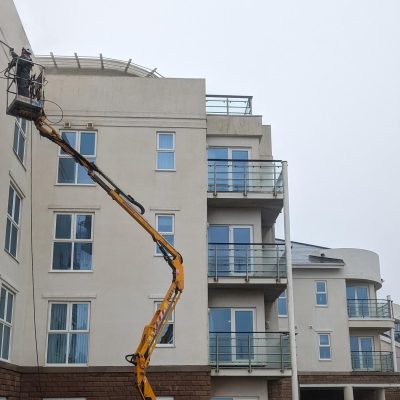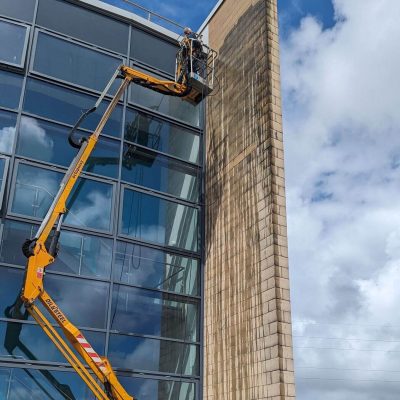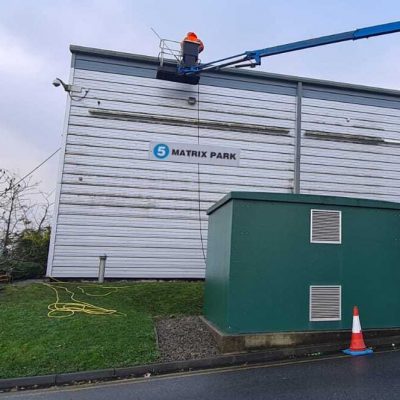If you’re in the market looking to hire a boom lift, two of the most common types you’ll come across are:
- articulating booms and
- telescopic booms.
Both have their advantages and disadvantages depending on the application.
In this blog post, we’ll provide an in-depth look at articulated boom lift vs telescopic boom lift to help you make an informed decision.
What is an Articulating Boom?
An articulating boom consists of multiple hinged boom sections that are connected together and can be manoeuvred independently.
This allows the boom to bend and move in multiple directions, providing access over, under and around obstacles. The articulating knuckle joints give it a lot of versatility to position the work platform exactly where it needs to be.
Articulating booms are ideal for working in confined spaces with limited mobility. The multiple articulation points allow the operator to snake the platform through tight access points and around obstructions to reach the work area.
This makes them well-suited for indoor applications like convention centres, arenas and warehouses with lots of infrastructure like ductwork and lighting fixtures.
For Outdoors: Articulated boom can navigate through tree branches or in between buildings and other structures. The up-and-over outreach allows accessing the sides and roof of buildings for exterior maintenance and construction work.
The jointed design provides better manoeuvrability on rough or uneven terrain compared to a straight telescopic boom.
Moving forward to –
What is a Telescopic Boom?
A telescopic boom consists of nesting boom sections that extend straight out from the rotator turntable to provide extra horizontal reach. The sections telescope in and out to adjust the overall length of the boom for increased vertical and horizontal reach.
Unlike an articulating boom, a telescopic boom has no knuckle joints. It simply extends outwards on a single plane, maintaining a straight configuration. The greater horizontal outreach enables positioning the work platform further away from the base of the lift.
Telescopic booms are ideal for high reach applications with wide open job sites that don’t require complex manoeuvring. The straight boom allows for quicker, simpler positioning compared to articulating the boom sections.
This makes them well-suited for exterior work on tall structures like high-rise buildings, arena rooftops, cell towers and billboards.
The extended reach also suits telescopic booms well for accessing bridges, overpasses and other elevated work areas. Their ability to reach up and out is an advantage for painting, HVAC, electrical and other construction and maintenance tasks.
Key Difference Between Articulating Boom Lifts & Telescopic Boom Lifts
Now that we’ve provided an overview of each type, let’s look at some of the key differences between articulating and telescopic booms:
| Criteria | Telescopic Boom | Articulating Boom |
| Reach | Greater horizontal reach | Greater up and over reach |
| Maneuverability | Moves in a straight line | Can snake through tight spaces and around obstacles |
| Strength | Can handle greater platform capacities at height | Lower weight capacities when fully extended |
| Speed | Generally faster to position | Requires manoeuvring multiple joints |
| Terrain | Works better on flat, stable surfaces | Handles rough terrain better |
| Height | Can reach greater heights (upwards of 150 feet or more) | Maxes out around 120 feet |
| Indoors vs Outdoors | Excel outdoors | Better suited for confined indoor spaces |
As you can see, there are some clear tradeoffs between them. Your work environment and access needs will determine which type works best.
Articulating Boom Applications
Now that we’ve compared the two types of booms, let’s look more closely at situations where an articulating boom would be the preferred choice:
Indoor Worksites
If you need to navigate a lift through doorways, aisles and rafters, around ductwork and lighting, an articulating boom is your best bet. The jointed knuckle boom provides the manoeuvrability to snake the platform into tight spaces that would be difficult or impossible to access with a straight telescopic boom.
Warehouse maintenance, convention centres, stadiums and arena roof access are prime examples.
Accessing Sides of Buildings
Trying to reach around obstructions to access the sides or backsides of structures is easier with an articulating boom. The up-and-over capability allows you to position the platform over or around impediments to reach the work area.
This makes maintenance tasks like window cleaning, painting and roof cleaning/repairs etc much simpler.
Working Near Power Lines
For utilities, tree care and other applications where you need to work around power lines, an articulating boom allows better manipulation to avoid electrocution hazards. The jointed design makes it easier to manoeuvre the boom and platform around energised lines.
Rough, Sloped Terrain
Unstable, uneven ground can make it difficult to position a straight telescopic boom. Articulating booms provide better stability on rough terrain since the jointed sections conform better to the landscape. The oscillating axle on most models also aids in handling slopes and inclines.
Frequent Repositioning
If your work involves constantly moving the work platform to new positions around a job site, an articulated boom allows faster repositioning. The ability to manoeuvre in multiple directions with the jointed boom speeds up the process compared to collapsing and extending a telescopic boom.
Limited Space
Articulating booms take up less space when positioned for transport and storage. Rather than fully retracting like a telescopic boom, you simply lower the articulating boom into a cradle. This saves space that would be required for the extended length of a telescoped boom.
Now –
Telescopic Boom Applications
In contrast, here are situations that are better suited for a telescopic boom lift:
High Reach
If you need to reach heights upwards of 125 feet or more, a telescopic boom is the clear choice. The extending sections allow much greater vertical and horizontal reach than an articulating boom.
Maintenance on tall structures like stadium lights, cell towers, wind turbines and high rises are prime examples.
Greater Horizontal Reach
To position the work platform further away from the base, a telescopic boom provides significantly more horizontal reach. This allows accessing areas that may be unworkable with the shorter horizontal reach of an articulated boom.
Bridge inspection, elevated tank maintenance and sign installation are typical applications.
Lifting Heavy Loads
Telescopic booms maintain greater strength and stability at height, enabling them to handle heavier platform capacities. Articulating booms lose strength when fully extended, limiting the payload capacity. If you need to lift heavy equipment or materials, a telescopic boom can manage greater loads.
Wide Open Job Sites
For applications like construction sites, sports fields and outdoor venues where you don’t have to manoeuvre around enclosed obstacles, a telescopic boom provides faster positioning. The straight extension allows you to reach the required height and outreach without articulating joints.
Working on Flat Surfaces
Telescopic booms perform best on firm, level terrain where the entire weight remains centred over the chassis. Their limited ability to adapt to irregular ground makes an articulated boom preferable for rough or sloping surfaces.
Frequent Operation at Height
If your tasks require extended periods of working at height, a telescopic boom allows you to remain in position without constant repositioning. Articulating booms are better suited for applications requiring continual repositioning at varying heights.
Limited Ground Obstructions
Without ground obstacles like close walls and ceilings that require snaking around, a telescopic boom can utilise its full vertical and horizontal reach. Open outdoor job sites allow taking advantage of greater heights and outreach distances.
As you can see, telescopic booms are ideal for wide open areas that require substantial reach. Their high height capacity also suits construction jobs where materials and loads need to be lifted to elevated work platforms.
Parting Words
Assess your particular worksite access needs and compare the capabilities of both types.
This will lead you to the right model to maximise productivity while keeping operators safe. If you’re still unsure which is best for your situation, call us today and we’ll help you match the right equipment to your specific application.



